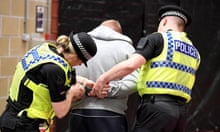Transgender people in England and Wales are twice as likely to be victims of crime as cisgender people, official figures show.
Data from the Office for National Statistics (ONS) shows more than one in four trans people (28%) experienced crime in the year ending March 2020, compared with 14% of people whose gender identity is the same as the sex they were registered at birth.
It is the first time the UK statistics authority has published data on the gender identity of victims of crime in its annual survey.
Figures also showed that white people were the least likely to have experienced crime, at 13%, while people of mixed or multiple ethnic backgrounds were most likely to be victims, at 20%.
Those of Asian ethnic backgrounds were also more likely to be the victim of an offence than white people, with 15% experiencing crime last year.
Meanwhile, sexuality also play a role in the likelihood of being a victim of a crime. Heterosexual people were less likely to have experienced a crime (14%), than those who identified as gay, lesbian or bisexual (21%).
The ONS said it had not included fraud and computer use in the data breakdown because other offences were less likely to be “targeted” towards people from certain demographics.
The types of crimes that the groups were victim to was not included in the data, but the ONS said that overall, offences fell by 9% in the past year. The “significant” reduction was partly driven by falls in theft and criminal damage, it said.
However, some categories saw an increase, including knife crime, which rose by 6% to a record high of 46,265 recorded offences.
Rates varied across the country, although many police forces saw an increase in knife crime, including Gwent (56%), Essex (51%) and Cambridgeshire (49%).
About a third (34%) of all the offences were recorded in London, while the number of stabbings that resulted in a death in the capital also rose by 28%.
Across the country, murder and manslaughter also rose by 10% compared with the previous year to 683 deaths. However, the ONS noted the total included the deaths of 39 people who were found inside a lorry in Essex last October.
Data from Greater Manchester police was not included in the ONS release because of issues with the force’s data records following the installation of new IT systems.










